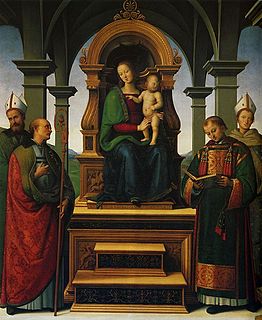 W
WDecemviri Altarpiece is a painting by the Italian Renaissance artist Pietro Perugino, executed in 1495-1496, and housed in the Pinacoteca Vaticana in Vatican City.
 W
WCaravaggio created one of his most admired altarpieces, The Entombment of Christ, in 1603–1604 for the second chapel on the right in Santa Maria in Vallicella, a church built for the Oratory of Saint Philip Neri. A copy of the painting is now in the chapel, and the original is in the Vatican Pinacoteca. The painting has been copied by artists as diverse as Rubens, Fragonard, Géricault and Cézanne.
 W
WThe Marsuppini Coronation is a painting of the Coronation of the Virgin by the Italian Renaissance painter Filippo Lippi, dating to after 1444. It is in the Pinacoteca Vaticana, Rome.
 W
WThe Oddi Altarpiece is an altarpiece of the Coronation of the Virgin painted in 1502-1504 by the Italian Renaissance master Raphael for the altar of the Oddi family chapel in the church of San Francesco al Prato in Perugia, Italy, now in the Vatican Pinacoteca. The altarpiece was commissioned for the Oddi family chapel in San Francesco al Prato in Perugia, was taken to Paris in 1797 and with 1815 brought back to Italy, not to Perugia but to the Vatican Pinacoteca.
 W
WCopies by Vincent van Gogh form an important group of paintings executed by Vincent van Gogh between 1887 and early 1890. While at Saint-Paul asylum in Saint-Rémy-de-Provence, France, where Van Gogh admitted himself, he strived to have subjects during the cold winter months. Seeking to be reinvigorated artistically, Van Gogh did more than 30 copies of works by some of his favorite artists. About twenty-one of the works were copies after, or inspired by, Jean-François Millet. Rather than replicate, Van Gogh sought to translate the subjects and composition through his perspective, color, and technique. Spiritual meaning and emotional comfort were expressed through symbolism and color. His brother Theo van Gogh would call the pieces in the series some of his best work.
 W
WThe San Francesco al Prato Resurrection is a painting by the Italian Renaissance painter Pietro Perugino, dating to c. 1499. It is housed in the Pinacoteca Vaticana, Rome.
 W
WSixtus IV Appointing Platina as Prefect of the Vatican Library is a fresco transferred to canvas by the Italian Renaissance artist Melozzo da Forlì, once decorating the Vatican Library, now housed in the Pinacoteca Vaticana in Rome.
 W
WSaint Jerome in the Wilderness is an unfinished painting by Italian Renaissance artist Leonardo da Vinci, now in the Vatican Museums. The composition of the painting has been drafted in monochrome onto the primed wooden panel. At an unknown date after Leonardo's death, the panel was cut into five pieces before eventually being restored into its original form.
 W
WThe Stefaneschi Altarpiece is a triptych by the Italian painter Giotto, commissioned by Cardinal Giacomo Gaetani Stefaneschi to serve as an altarpiece for one of the altars of Old St. Peter's Basilica in Rome.
 W
WThe Transfiguration is the last painting by the Italian High Renaissance master Raphael. Commissioned by Cardinal Giulio de Medici, the later Pope Clement VII (1523–1534), and conceived as an altarpiece for the Narbonne Cathedral in France, Raphael worked on it until his death in 1520. The painting exemplifies Raphael's development as an artist and the culmination of his career. Unusually for a depiction of the Transfiguration of Jesus in Christian art, the subject is combined with the next episode from the Gospels in the lower part of the painting. The Transfiguration stands as an allegory of the transformative nature of representation. It is now in the Pinacoteca Vaticana in Vatican City.